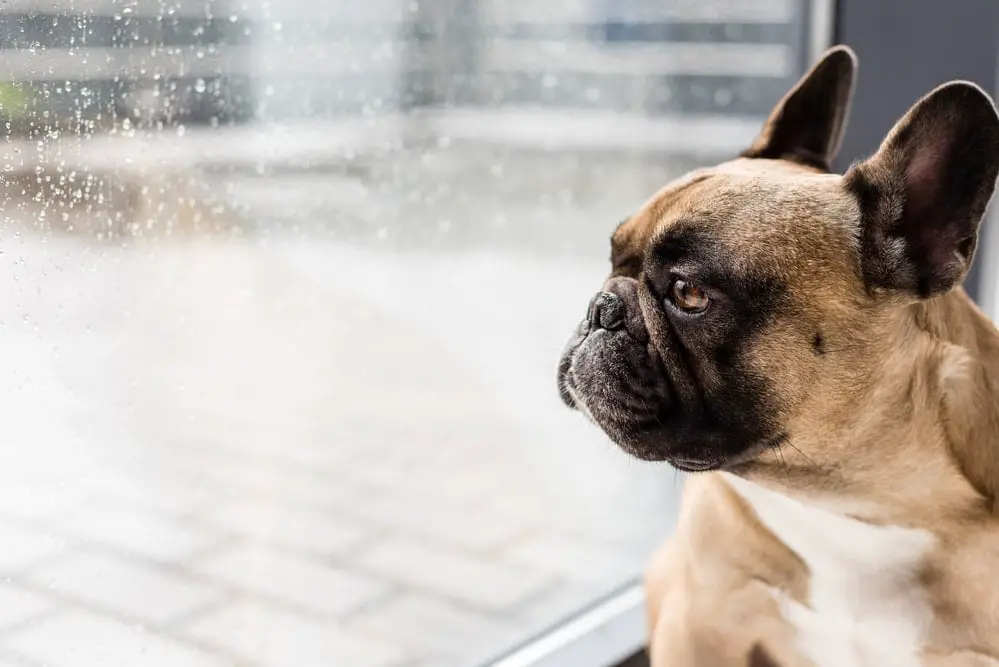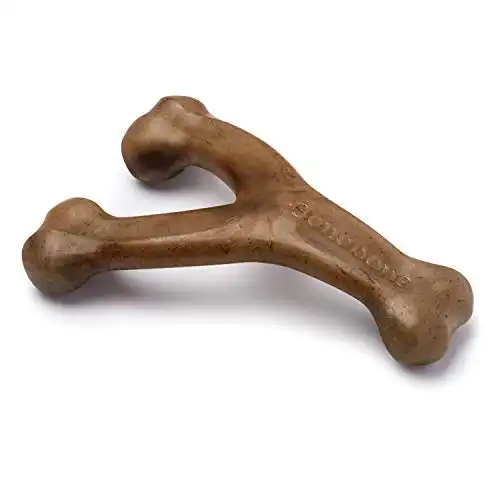As dog owners, we probably appreciate it when our dog misses us when we leave than not. But, for some dogs, this turns into a great level of distress. It’s crucial to help a dog with separation anxiety so that they aren’t behaving destructively or causing harm to themselves or your home when you are gone.
There is a number of techniques to use to train a dog or to help a dog already experiencing separation anxiety, and there’s help out there when the issue needs further assistance.
What is Separation Anxiety in French Bulldogs?
Separation anxiety is when your dog experiences distress when you are away. Dogs typically experience this immediately or soon after you leave them. While some Frenchies may suffer from separation anxiety, others may not. There’s no known reason why some dogs do, and some don’t (other than obvious situations such as a new home, new family, or new illness).
How to Know if Your Frenchie Has Separation Anxiety
You will likely be able to tell if your dog suffers from separation anxiety. Becoming aware of this is the first step to helping a dog with separation anxiety.
Look for these signs:
- Using the bathroom in their crate or your home when you leave (especially if it’s only for a short time)
- Excessive barking or howling
- Destructive behaviors like chewing, digging, or tearing things up
- Escaping from the area the dog is confined to
- Seemingly uneasy right before you leave them
It is very likely that before you leave your dog and/or when you return, they are displaying behaviors that one would display when severely stressed.
Ways to Help Your Anxious Frenchie
There are several tricks to help a dog with separation anxiety feel better when you leave, if it is mild to moderate.
Avoid Signals Which Indicate You’re Leaving
Dogs truly are smart, and if you always perform the same actions before you leave, your Frenchie will learn to recognize them. For example, getting your keys out and/or putting your dog in its crate.
Knowing that these actions mean you are about to leave will result in your dog’s anxiety to start building as they await the next step (you leaving).
To prevent this, try to be unpredictable. You can do this by getting your keys out at times when you have no intention of leaving soon or letting your dog have mealtime in their crate when you are at home. You can also change the order of the steps you take before leaving.
Another leaving signal most pet owners display to their dogs is actually telling them. Most doggy parents give pets, kisses, and sweet “goodbyes.” Of course, we want our pups to know we love them and we will be back, but it does add to the process of leaving and can add to their anxiety.
Proper Crate Training
Properly crate training your dog can make an enormous difference when leaving your French Bulldog. You can read all the tips and tricks for this here. If your pup loves its crate and it’s a safe place, this can provide a sense of security when you leave.
Start Small
Avoid overwhelming your French Bulldog with too much time away from you from the start. Again, look into crate training your dog from a puppy (or as soon as you get it).
Upon getting your new Frenchie, leave it for a very short time, or have another person (i.e., a family member or pet sitter) stay with your dog when you leave, at least for the first several days. This can make a difference since your home is very new to them, and they will surely experience some uneasiness.
If you don’t have an extra person to help, that’s okay. Practice leaving them for a short time by not actually leaving and simply stepping into another one and eventually outdoors out of sight. Slowly increase the time that you leave them.
Your Scent
Leaving items with your scent on them can provide comfort to your dog when you are away, especially if they are in a crate. You could leave a shirt or scarf you’ve worn that still has your scent.
Exercise
An excellent trick to help a dog with separation anxiety is to exercise them before you leave. If your Frenchie is tired and doesn’t have too much energy, there’s a better chance of them relaxing while you are away. Provide ample playtime or a walk before you plan to leave them.
Treats and Toys
Treats and toys help any situation! Provide treats before you go so that your dog has something to be excited about. Toys will also give your dog something to do while you are away.
Ensure that the toys you leave for your dog while unsupervised are safe, like the Benebone Durable Wishbone (a large toy that they can’t swallow, no small pieces, no strings).
- DURABLE, LONG-LASTING – Super chewer? Bring it on. Benebones are tougher than real bones and last for weeks.
- REAL BACON! – We use only 100% REAL BACON for flavor. Trust us, dogs can tell the difference.
- EASY TO PICK UP AND CHEW – The Wishbone is curved for a paw-friendly grip so your pup can quickly grab it and get a good chew going. Think about it: dogs don’t
A Kong with frozen peanut butter and/or banana pieces is a great treat and toy that will occupy them for a bit of time.
- Instinctual Needs: The KONG Classic red rubber toy helps satisfy dogs' instinctual needs while providing mental stimulation. Healthy play is important for dogs' physical and mental development, emotions and behavior. By encouraging healthy play and satisfying instinctual needs, this treat dispensing puzzle toy helps solve chewing, separation anxiety, teething, boredom, weight management, crate training, digging and barking
- Fetch Toy: The KONG Classic's unpredictable bounce makes for exciting games of fetch and other interactive play with your pet. This is a fun way for average chewers to get the exercise they need
- Great For Stuffing: The stuffable KONG Classic is even more enticing when treat filled with bits of kibble, peanut butter, KONG Easy Treat, Snacks or Ziggies. Dishwasher safe for easy clean up. Bonus: For an added challenge, freeze stuffed KONG for 4-6 hours before giving to your dog
Have Empathy
Empathy may be the most important technique to help a dog with separation anxiety. It’s essential to understand that your dog is not intentionally acting out and that punishment is far from helpful. A Frenchie’s behavior due to separation anxiety can be extremely frustrating, but reprimanding your pup for misbehaving will only amplify their distress.
How to Help a Dog with More Severe Anxiety
There are times when the previous tricks simply don’t help or don’t give the results you’d like to see. Many dogs do suffer from more severe separation anxiety, especially if you get your Frenchie once they pass the puppy age.
To help a dog with separation anxiety that you can’t seem to get under control, there’s help.
A Dog Behaviorist
A dog behaviorist can provide further assistance; rather it is from extra training or advice on anxiety medication options.
A medicine route should be taken only if all other techniques used simply don’t help.
Doggy Daycare or Pet Sitter
Another step you can take to help a dog with anxiety is to send your pup to doggy daycare or get a pet sitter to come to your home. Allowing your pup to become comfortable with someone else can prove very useful.
Doggy daycare can get expensive, but many places offer discounts for packages. Some dogs are also anxious to go to a new place, but the good part is that they usually get used to it, and they also have time to exercise, allowing them to get their mind off of missing you so much.
A pet sitter is also a great option. A pet sitter can stay with your dog or visit it once or twice throughout the day to relieve your dog’s stress for a bit of time and make sure it is doing okay. Time for exercise midday with a dog walker can also allow your pup to relax a bit until you are able to get back home.
In Conclusion
Just like for humans, anxiety in dogs can be debilitating and result in undesired behaviors. As much as dog owners may desire to stay at home with their loving pup and cuddle or play all day, we know that’s not always feasible.
While it can be disheartening to witness a distressed Frenchie, implementing ways to help a dog with separation anxiety are sure to make a difference.
Frequently Asked Questions
What is separation anxiety in French Bulldogs?
Separation anxiety is when a dog experiences distress when their owner is away. French Bulldogs may suffer from separation anxiety, but it is not a guaranteed condition for all Frenchies.
How can I tell if my Frenchie has separation anxiety?
Look for signs such as using the bathroom in the house or crate when you leave, excessive barking or howling, destructive behaviors, escaping from confinement, and appearing uneasy before you leave.
How can I help my Frenchie with separation anxiety?
Techniques to help your dog with separation anxiety include avoiding signals that indicate you’re leaving, proper crate training, starting small with time away, leaving items with your scent, providing exercise before leaving, and giving treats and toys to occupy them while you’re away.
What types of toys are safe for a Frenchie with separation anxiety?
Safe toys for a Frenchie with separation anxiety include durable, non-toxic options like the Benebone Durable Wishbone and Kong Classic Dog Toy filled with frozen peanut butter or banana pieces.


